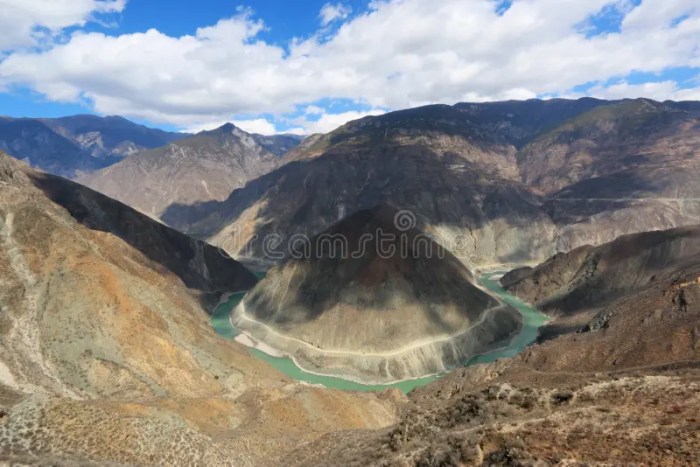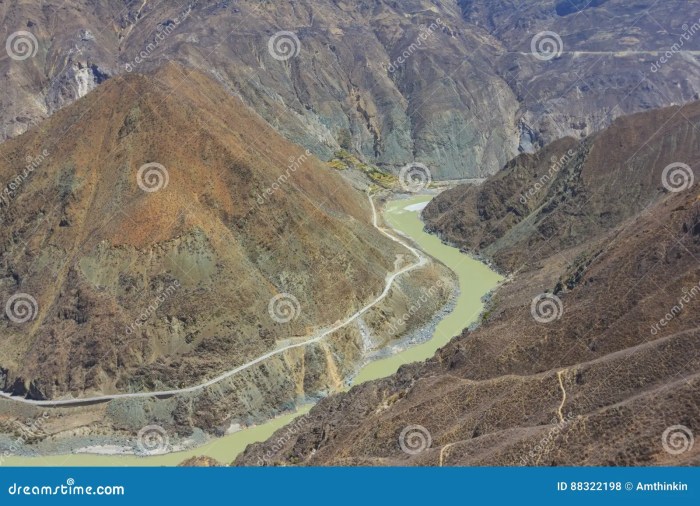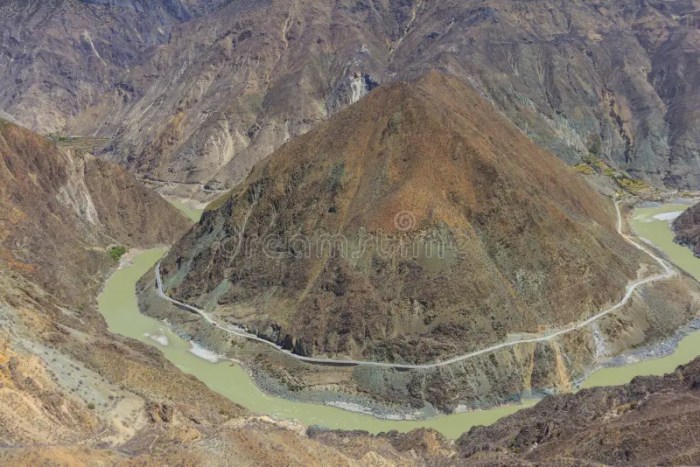Omega shaped curve in a river – In the realm of river morphology, the enigmatic omega-shaped curve stands as a testament to the intricate dance between water and land. These captivating bends in a river’s path hold profound significance, shaping the very fabric of the aquatic ecosystem.
As we delve into the world of omega-shaped curves, we will uncover their defining characteristics, explore the hydrodynamic processes that shape them, and unravel their ecological implications. Prepare to be captivated as we embark on a journey through the sinuous embrace of these riverine wonders.
Introduction: Omega Shaped Curve In A River

An omega-shaped curve, also known as a sinuous bend or meander, is a distinctive pattern formed by a river as it flows through a landscape. It is characterized by a series of alternating curves, resembling the Greek letter omega (Ω).
Omega-shaped curves play a significant role in river morphology, as they influence the flow dynamics, sediment transport, and habitat diversity within the river system.
Significance in River Morphology
Omega-shaped curves affect river morphology in several ways:
- Erosion and Deposition:The outer bank of a curve experiences higher flow velocity, leading to erosion, while the inner bank experiences deposition, forming point bars.
- Sediment Transport:Curves create a helical flow pattern, which facilitates the transport and sorting of sediments, resulting in the formation of riffles and pools.
- Habitat Diversity:Omega-shaped curves create diverse habitats, ranging from deep pools and gravel bars to vegetated banks, supporting a variety of aquatic and riparian species.
- Flood Control:Meandering rivers can slow down floodwaters and reduce peak flows, as the curves increase the length of the river channel and provide additional storage capacity.
Characteristics of Omega-Shaped Curves
Omega-shaped curves, also known as horseshoe bends, are distinctive river features characterized by their sinuous, elongated shape resembling the Greek letter omega (Ω). These curves are common in meandering rivers and are formed through a combination of erosional and depositional processes.
Omega-shaped curves typically exhibit certain dimensions and geometric properties. Their length can vary significantly, ranging from a few hundred meters to several kilometers. The width-to-length ratio is typically low, indicating a narrow, elongated shape. The sinuosity of the curve, measured as the ratio of the channel length to the valley length, is generally high, indicating a high degree of meandering.
Factors Influencing Formation
The formation of omega-shaped curves is influenced by a combination of factors, including the river’s sinuosity, slope, and discharge. High sinuosity promotes the development of curves as the river flows around obstacles and erodes the outer banks. Steep slopes increase the erosive power of the river, leading to the formation of deeper channels and more pronounced curves.
Conversely, low slopes favor deposition, which can fill in curves and reduce their sinuosity.
Discharge also plays a role in the formation and maintenance of omega-shaped curves. High discharge can increase the erosive power of the river, leading to the formation of larger and more pronounced curves. Conversely, low discharge can result in deposition, which can fill in curves and reduce their sinuosity.
Hydrodynamic Processes

Omega-shaped curves are influenced by various hydrodynamic processes that shape their distinctive morphology. These processes involve the interplay of flow velocity, turbulence, and erosion.
Flow Velocity
Flow velocity plays a crucial role in shaping omega-shaped curves. As water enters the curve, its velocity increases along the outer bank and decreases along the inner bank. This differential velocity creates a pressure gradient, with higher pressure on the outer bank and lower pressure on the inner bank.
The pressure gradient drives water towards the inner bank, resulting in erosion and the formation of a point bar.
Turbulence
Turbulence is another important hydrodynamic process that contributes to the formation of omega-shaped curves. As water flows around the curve, it encounters obstacles such as the riverbed and banks, which create turbulence. Turbulence increases the erosive power of the water, leading to the formation of chutes and pools.
Chutes are areas of high velocity and erosion, while pools are areas of lower velocity and deposition.
Erosion
Erosion is the primary process responsible for shaping omega-shaped curves. The combination of flow velocity and turbulence leads to erosion of the riverbanks, particularly along the outer bank. As the outer bank erodes, the river widens and the curve becomes more pronounced.
The eroded material is transported downstream and deposited on the inner bank, forming a point bar.
Sediment Transport
Omega-shaped curves significantly influence sediment transport dynamics within river systems. These curves create unique hydrodynamic conditions that facilitate both deposition and erosion of sediment, shaping the river’s morphology and ecology.
On the outer bank of the curve, where the water velocity is higher, sediment is eroded and transported downstream. Conversely, on the inner bank, where the velocity is lower, sediment is deposited, forming point bars. This differential erosion and deposition create a characteristic asymmetrical cross-section in omega-shaped curves.
Sediment Deposition
- The inner bank of the curve experiences lower water velocity, allowing sediment to settle and accumulate.
- The formation of point bars on the inner bank creates shallow, slow-moving areas that further promote sediment deposition.
Sediment Erosion
- The outer bank of the curve experiences higher water velocity, which erodes sediment and transports it downstream.
- The presence of a scour hole on the outer bank indicates the intense erosive forces acting in this area.
Ecological Implications

Omega-shaped curves are significant ecological hotspots in river systems, providing diverse habitats for aquatic organisms. Their unique morphology and hydrodynamic processes create a mosaic of microhabitats that support a wide range of species.
The slow-moving waters on the inside of the curve create calm zones that are ideal for vegetation growth. Submerged aquatic plants, such as water lilies and duckweed, thrive in these areas, providing food and shelter for various invertebrates, amphibians, and fish species.
The vegetation also helps stabilize the riverbank, reducing erosion and providing additional habitat for organisms.
Influence on Biodiversity
The diversity of habitats within omega-shaped curves contributes to increased biodiversity in river systems. The different microhabitats provide niches for various species with specific ecological requirements. For example, the shallow, slow-moving waters on the inside of the curve are suitable for species that prefer calm environments, such as frogs, turtles, and some fish species.
In contrast, the faster-flowing waters on the outside of the curve attract species that prefer higher water velocities, such as certain types of fish and aquatic insects.
Geomorphic Evolution

Omega-shaped curves are dynamic landforms that undergo constant geomorphic evolution over time. Their formation, migration, and abandonment are influenced by a complex interplay of hydrodynamic processes, sediment transport, and ecological factors.
The initial formation of an omega-shaped curve typically occurs when a river encounters a resistant bedrock outcrop or other obstacle that deflects the flow. As the river erodes the obstacle, a bend is created, which gradually develops into an omega shape due to the erosion of the outer bank and deposition on the inner bank.
In the realm of fluvial geomorphology, the omega-shaped curve, reminiscent of the “camel saddle” concept in AP World History , describes a river’s meandering path. Just as the camel’s saddle allows for a comfortable ride, the omega-shaped curve ensures efficient water flow and sediment transport, shaping the river’s landscape over time.
Migration
Once formed, omega-shaped curves tend to migrate downstream over time. This migration is driven by the erosion of the outer bank and the deposition of sediment on the inner bank. The rate of migration is influenced by factors such as the river’s discharge, sediment load, and bank erodibility.
Abandonment
In some cases, omega-shaped curves can become abandoned. This occurs when the river’s course changes, either due to natural processes or human intervention. When a curve is abandoned, it is typically replaced by a straighter channel. The abandoned curve may remain as a relic landform or may be gradually filled in with sediment.
Human Impacts
Human activities can have a significant impact on the formation and evolution of omega-shaped curves in rivers.
River engineering, land use changes, and climate change can all alter the flow of water and sediment in rivers, which can in turn affect the shape of these curves.
River Engineering, Omega shaped curve in a river
- River engineering projects, such as the construction of dams, levees, and bridges, can alter the flow of water and sediment in rivers.
- These changes can lead to the formation of new omega-shaped curves or the modification of existing ones.
Land Use Changes
- Land use changes, such as the conversion of forest to agriculture or urban development, can also affect the flow of water and sediment in rivers.
- These changes can lead to increased erosion and sedimentation, which can in turn affect the shape of omega-shaped curves.
Climate Change
- Climate change is expected to lead to changes in the frequency and intensity of floods and droughts.
- These changes can also affect the flow of water and sediment in rivers, which can in turn affect the shape of omega-shaped curves.
Management and Conservation
The significance of omega-shaped curves in riverine ecosystems necessitates effective management and conservation strategies to safeguard their ecological integrity and water resources.
Omega-shaped curves are vital habitats for a diverse array of aquatic and riparian species, providing essential breeding, feeding, and shelter grounds. They contribute to the overall health and resilience of river ecosystems by supporting food webs, filtering pollutants, and regulating water flow.
Strategies for Management and Conservation
- Maintain Riparian Buffers:Preserving natural vegetation along riverbanks helps stabilize banks, reduce erosion, and filter pollutants, safeguarding the integrity of omega-shaped curves.
- Control Development:Regulating development activities near riverbanks minimizes disturbance to these sensitive areas, protecting water quality and habitat for aquatic life.
- Manage Water Withdrawals:Ensuring sustainable water withdrawals prevents excessive flow alterations that can disrupt the natural dynamics and morphology of omega-shaped curves.
- Restore Degraded Curves:Implementing restoration projects to rehabilitate degraded omega-shaped curves can enhance habitat quality, improve water flow, and restore ecological functions.
Common Queries
What factors influence the formation of omega-shaped curves?
Factors such as river sinuosity, slope, and discharge play a crucial role in shaping omega-shaped curves.
How do omega-shaped curves impact sediment transport?
These curves facilitate both the deposition and erosion of sediment, influencing the river’s morphology and sediment distribution.
What ecological benefits do omega-shaped curves provide?
They offer diverse habitats for aquatic organisms, supporting biodiversity and enhancing the overall health of the riverine ecosystem.